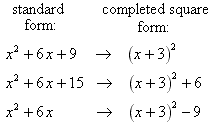Chapter 9 - Quadratics and quadratic equations
This chapter discusses quadratics. It contains the following sections:- section 9.1 - In this section we introduce quadratic expressions, quadratic equations, quadratic functions and parabolas.
- section 9.2 - In this section we explain the “completing the square” method, a versatile method that is the basis for factoring any quadratic trinomial and solving any quadratic equation.
- section 9.3 - In this section we show how the completing-the-square method can be used to factor any quadratic trinomial.
- section 9.4 - In this section we show how to solve quadratic equation by four different methods:
9.1 - Introduction to quadratics
Definition: A quadratic expression is an expression of the form: a x 2 + b x + c,where x is a variable and a, b, and c are constants, and a is not equal to zero. The term a x 2 is called the quadratic term, b x is called the linear term and c is called the constant term. The constant a is called the leading coefficient, b is called the linear coefficient, and c is called the additive constant. |
Example: These are quadratic expressions:
- x 2 − 3 x + 2
- −5 x 2 + 7
We can create a quadratic function called, say f, whose input is x and whose output, f (x), is the quadratic expression evaluated at x:
a x 2 + b x + c
Example: f (x) = x 2 − 3 x + 2 is a quadratic function. If we let the input be, say x = 4, then the output is f (4) = 4 2 − 3 · 4 + 2 = 6.
We can give the output of the quadratic function the name “y” and make a graph of y versus x. We will get a curve like the four curves shown below. These curves are called parabolas. They feature a point called the vertex where the parabola reaches its maximum height or depth and turns around. The parabola opens upward if a > 0 and opens downward if a < 0 but its exact location depends on the values of all three constants a, b and c. In the picture below, parabolas (a), (c) and (d) open upward and have their vertex at the bottom. Parabola (b) opens downward and has its vertex at the top.
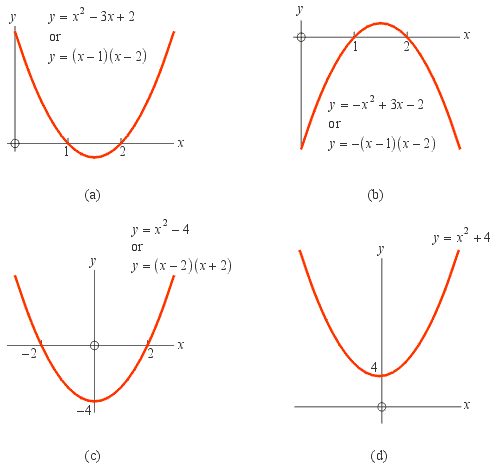
If we set the quadratic expression equal to zero or if we set y = 0 or f (x) = 0 then we get the so-called quadratic equation:
a x 2 + b x + c = 0.(Note that setting y = 0 in the graph means that we are looking at points where the parabola crosses the x axis, and setting f (x) = 0 in the quadratic function means that we are looking for values of x for which the output of the quadratic function is zero.)
There is a close connection between:
- The values of x that cause a quadratic expression to equal zero.
- The places where a quadratic function’s graph (the parabola) crosses the x axis.
- The roots or solutions of a quadratic equation.
- The factors of a quadratic expression.
Example: By studying figure (a) above we see that the following are equivalent:
- The quadratic function’s graph (i.e. the parabola) y = x 2 − 3 x + 2 crosses the x axis at x = 1 and x = 2.
- The quadratic equation x 2 − 3 x + 2 = 0 has solutions x = 1 and x = 2.
- The quadratic expression x 2 − 3 x + 2 can be factored into (x − 1)(x − 2).
- Letting x = 1 makes the first factor equal zero and letting x = 2 makes the second factor equal zero. Either factor equalling zero makes the quadratic expression equal zero.
Example: By studying figure (d) above we see that the following are also equivalent:
- The quadratic function’s graph (parabola) y = x 2 + 4 does not cross the x axis.
- The quadratic equation x 2 + 4 = 0 does not have real solutions. (It does however have complex solutions.)
- The quadratic expression x 2 + 4 cannot be factored
over the real numbers.
(It can however be factored over the complex numbers.)
9.2 - The completing-the-square method
The completing the square method takes a quadratic trinomial in which the variable, call it x, occurs twice (shown here in red) and rewrites it in such a way that x only occurs once:The method is based on factoring perfect square quadratic trinomials. Look at the following three examples where three quadratic trinomials in standard form on the left have been converted to completed square form on the right:
(You should distribute the expressions on the right and verify that they do equal the expressions on the left.) The first example was chosen to be a perfect square quadratic trinomial. Notice that its completed square form is exactly the same as its factored form.
In the second example the trinomial’s additive constant, 15, is 6 bigger than the additive constant, 9, in the first example. Notice that in the completed square form this surplus of 6 is just added on at the end.
Finally, in the third example the additive constant, 0, is 9 smaller than the additive constant in the first example. In the completed square form this deficit of 9 is just subtracted off at the end.
Conclusion: The completed square form is just the perfect square in factored form with some remainder constant tagged on at the end. |
Here is a recipe for converting a quadratic to completed square form. This recipe also explains what to do if the leading coefficient a of the quadratic is not equal to 1.
Convert a quadratic expression to completed square form by following these steps:
|
Example: Convert the quadratic trinomial x 2 + 6 x − 5 to completed square form.
Solution: Follow these steps:
- This quadratic trinomial has coefficients a = 1, b = 6, and c = −5.
Since it is already in standard form and since the leading coefficient is 1
we can proceed straight to step 3.
Take the coefficient of the linear term, divide it by 2, and then
square it. This gives 9.
- Add 9 and subtract 9 back off again just after the linear term, like this:
x 2 + 6 x + 9 − 9 − 5.
- Use brackets to group the first 3 terms. The bracketed group had 9
added to it to make it a perfect square. The rest
of the expression had 9 subtracted from it. Call it the rest:
(x 2 + 6 x + 9) − 9 − 5.
- Factor the perfect square group and simplify the rest:
(x + 3) 2 − 14.
Example: Convert the quadratic trinomial 2 x 2 + 9 x − 20 to completed square form.
Solution: Just for variety we will complete the square on this one using floating point rather than exact arithmetic (i.e. decimal numbers rather than fractions). Follow these steps:
- This quadratic trinomial has coefficients
a = 2, b = 9, and c = −20.
Since it is already in standard form and we can proceed straight to step 2.
Factor out the coefficient of the quadratic term:
2 ( x 2 + 4.5 x − 10)
- Now look inside the brackets. Take the coefficient of the linear term,
divide it by 2, and then square it. This gives 5.0625.
- Add 5.0625 and subtract 5.0625 back off again just after the linear term, like this:
2 (x 2 + 4.5 x + 5.0626 − 5.0625 − 10)
- Use square brackets to group the first 3 terms. This square-bracketed group had 5.0625
added to it to make it a perfect square. The rest
of the expression had 5.0625 subtracted from it. Call it the rest:
2 ( [x 2 + 4.5 x + 5.0626] − 5.0625 − 10)
- Factor the perfect square group and simplify the rest:
2 ( [x + 2.25] 2 − 15.0625)
The following example is based on these facts about parabolas:
|
Parabolas: The general equation of a parabola is: y = a x 2 + b x + c,where a, b and c are constants. From the general equation the only thing that you can say about the parabola is that it opens upward if a is positive and opens downward if a is negative. If you complete the square on the right-hand-side of this equation you get the so-called standard equation of a parabola: y = a(x − h) 2 + k,From this equation you can say that the vertex of the parabola is located at (h, k). |
Example: Given the parabola y = x 2 −2x + 10. Complete the square on the right side, find the vertex and then sketch the parabola.
Solution: Follow these steps to complete the square on the right side:
- The quadratic trinomial on the right-hand-side has coefficients a = 1,
b = −2, and c = 10.
Since it is already in standard form and since the leading coefficient is 1
we can proceed straight to step 3.
Take the coefficient of the linear term, divide it by 2, and then
square it. This gives 1.
- Add 1 and subtract 1 back off again just after the linear term, like this:

- Use brackets to group the first 3 terms. The bracketed group had 1
added to it to make it a perfect square. The rest
of the expression had 1 subtracted from it. Call it the rest:

- Factor the perfect square group and simplify the rest:

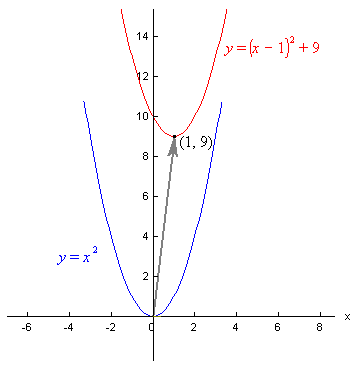
The following example is based on these facts about circles:
|
Circles: The general equation of a circle is: x 2 + y 2 + a x + b y + c = 0,where a, b and c are constants. If you complete the square twice, once on the x terms and once on the y terms, you get the so-called standard equation of a circle: (x − h) 2 + (y − k) 2 = r 2From this equation you can say that the center of the circle is at (h, k) and that the radius is r. |
Example: Given the circle x 2 + y 2 − 2 x + 4 y + 1 = 0. Complete the square twice, once on the x terms and once on the y terms. Use the result to find the center and radius of the circle and then sketch it.
Solution: Write the two x terms, leave a space, write the two y terms, leave another space, and then write the rest of the equation, like this:
To complete the square on the x terms, look only at the linear and quadratic x terms and ignore all the other terms (shown greyed out). Take the coefficient of the linear term, divide it by 2, and then square it. This gives 1. Add 1 and subtract 1 back off again in the space just after the linear term (shown in red), like this:
To complete the square on the y terms, look only at the linear and quadratic y terms and ignore all the other terms (shown greyed out). Take the coefficient of the linear term, divide it by 2, and then square it. This gives 4. Add 4 and subtract 4 back off again in the space just after the linear term (shown in blue), like this:
Altogether, you now have this:
Terms 1 to 3 are a perfect square in x and terms 5 to 7 are a perfect square in y. Put brackets around both perfect squares:
Write both perfect squares in factored form:
Add the three remaining numbers (to get −4), move this to the right side, and write it as the square of something (namely of 2):
This is the standard equation for this circle. From it we can tell that the circle has center at (1, −2) and radius 2. Here is a sketch of it (the red circle).
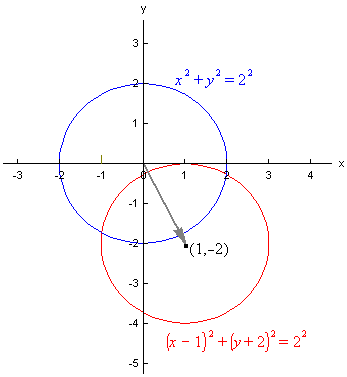
9.3 - Factoring quadratics by completing the square
The completing the square method can be used to factor any quadratic trinomial whatsoever. We assume that you have already read these sections:- Factoring quadratic trinomials.
This section shows methods for factoring quadratic trinomials,
a x 2 + b x + c,
in certain special cases. It also defines the discriminant.
- The completing the square method. This
section shows how any quadratic trinomial can be manipulated into
completed square form.
- Factoring a difference of squares. This section describes how to factor a difference of squares a 2 − b 2.
Here is the procedure for factoring any quadratic trinomial using the completing the square method:
|
Notes on the above formula:
-
The quantity b 2 − 4 a c
inside the square root is called the
discriminant,
denoted with the letter D.
If the discriminant is a perfect square (e.g. 1, 4, 9, 16, …) then the square
root of it will always be an integer. This explains why
we demanded that D be a perfect square in the
simpler methods
for factoring special trinomials. It guaranteed that the factors
would always contain simple integers.
- If D = 0 then the above formula reduces to the factorization of a
perfect square trinomial, namely:

- If D is negative then the above formula contains the square root of a negative number. Over the real numbers this is not allowed and means that the quadratic trinomial can't be factored, but over the complex numbers this is no problem. This case is described in detail below.
Example: Factor the expression x 2 + 6 x − 5.
Follow these steps:
- Identify the form of the expression. It is a quadratic trinomial with coefficients
a = 1, b = 6, and c = −5. Its discriminant is
D = b 2 − 4 · a · c
= 6 2 − 4 · 1 · (−5)
= 56, which is not a perfect square so we must factor the expression using the
completing the square method.
- The next four steps convert the expression to completed square form.
First take the coefficient of the linear term, divide it by 2, and then
square it. This gives 9.
- Add 9 and subtract 9 back off again just after the linear term, like this:
x 2 + 6 x + 9 − 9 − 5.
- Use brackets to group the first 3 terms. The bracketed group had 9
added to it to make it a perfect square. The rest
of the expression had 9 subtracted from it. Call it the rest:
(x 2 + 6 x + 9) − 9 − 5.
- Factor the perfect square group and simplify the rest:
(x + 3) 2 − 14.
- The expression is now in completed square form.
Write the rest as the square of its own square root:

- The expression is now a difference of squares.
It can be factored using the difference of squares formula:
a 2 − b 2 = (a + b) (a − b).
- Let a = x + 3 and b =
 .
This causes the difference of squares formula to read:
.
This causes the difference of squares formula to read:
The right side of this formula gives the expression in factored form.
Example: Factor the expression 2 x 2 + 9 x − 20.
Just for variety we will factor this one using floating point rather than exact arithmetic. Follow these steps:
- Identify the form of the expression. It is a quadratic trinomial with coefficients
a = 2, b = 9, and c = −20.
Its discriminant is
D = b 2 − 4 · a · c
= 9 2 − 4 · 2 · (−20)
= 241, which is not a perfect square so we must factor the expression using the
completing the square method.
- The next five steps convert the expression to completed square form.
Factor out the coefficient of the quadratic term:
2 ( x 2 + 4.5 x − 10)
- Now look inside the brackets. Take the coefficient of the linear term,
divide it by 2, and then square it. This gives 5.0625.
- Add 5.0625 and subtract 5.0625 back off again just after the linear term, like this:
2 (x 2 + 4.5 x + 5.0626 − 5.0625 − 10)
- Use square brackets to group the first 3 terms. This square-bracketed group had 5.0625
added to it to make it a perfect square. The rest
of the expression had 5.0625 subtracted from it. Call it the rest:
2 ( [x 2 + 4.5 x + 5.0626] − 5.0625 − 10)
- Factor the perfect square group and simplify the rest:
2 ( [x + 2.25] 2 − 15.0625)
- The expression is now in completed square form.
Write the rest as the square of its own square root:
2 ( [x + 2.25] 2 − 3.88 2 )
- Ignore the factor of 2 (shown above in red) for the moment.
The expression inside the round brackets is now a difference of squares.
It can be factored using the difference of squares formula:
a 2 − b 2 = (a + b) (a − b).
- Let a = x + 2.25 and b = 3.88.
This causes the difference of squares formula to read:
[x + 2.25] 2 − 3.88 2 = (x + 2.25 + 3.88) (x + 2.25 − 3.88)
- Simplifying the right side of this formula and remembering the factor
of 2 gives the expression in factored form:
2 (x + 6.13) (x − 1.63)
The complex case
We saw above that any quadratic trinomial a x 2 + b x + c can be factored as:The quantity b 2 − 4 a c inside the square root is called the discriminant, and is denoted with the letter D. If D is negative then the above formula contains square roots of negative numbers. Over the real numbers this is not allowed and means that the quadratic trinomial can't be factored. But if we are doing algebra over the complex numbers then the square root of a negative number is simply an imaginary number. Thus the only complication is that the factors contain imaginary numbers.
Example: Factor the expression x 2 + 4 x + 14.
We will factor using exact (rather than floating point) arithmetic. Follow these steps:
- Identify the form of the expression. It is a quadratic trinomial with coefficients
a = 1, b = 4, and c = 14.
Its discriminant is
D = b 2 − 4 · a · c
= 4 2 − 4 · 1 · 14
= −40. Since this is negative we know that the factors will be complex
and that we must factor the expression using the completing the square method.
- The next four steps convert the expression to completed square form.
First take the coefficient of the linear term, divide it by 2, and then
square it. This gives 4.
- Then add 4 and subtract 4 back off again just after the linear term, like this:
x 2 + 4 x + 4 − 4 + 14.
- Use brackets to group the first 3 terms. The bracketed group had 4
added to it to make it a perfect square. The rest
of the expression had 4 subtracted from it. Call it the rest:
(x 2 + 4 x + 4) − 4 + 14.
- Factor the perfect square group and simplify the rest:
(x + 2) 2 + 10.
- Procedure I: As before we write the rest as the
square of its own square root:

- The expression is now a sum of squares.
It can be factored using the sum of squares formula:
a 2 + b 2 = (a + b i ) (a − b i ).
- Let a = x + 2 and b =
 .
This causes the sum of squares formula to read:
.
This causes the sum of squares formula to read:

- Procedure II: Write the completed square expression
(x + 2) 2 + 10 as a difference instead
of a sum like this:
(x + 2) 2 − (−10)
- Now write the rest (shown above in red) as the square of its own square root:

- Now use the fact that the square root is imaginary,
 ,
so that:
,
so that:

- The expression is now a difference of squares.
It can be factored using the difference of squares formula:
a 2 − b 2 = (a + b) (a − b).
- Let a = x + 2 and b =
 i.
This causes the difference of squares formula to read:
i.
This causes the difference of squares formula to read:
The right side of this formula gives the expression in factored form.
Example: Factor the expression 2 x 2 + 9 x + 14.
We will factor using floating point arithmetic. Follow these steps:
- Identify the form of the expression. It is a quadratic trinomial with coefficients
a = 2, b = 9, and c = 14.
Its discriminant is
D = b 2 − 4 · a · c
= 9 2 − 4 · 2 · 14
= −31. Since this is negative we know that the factors will be complex
and that we must factor the expression using the completing the square method.
- The next five steps convert the expression to completed square form.
Factor out the coefficient of the quadratic term:
2 ( x 2 + 4.5 x + 7 )
- Now look inside the brackets. Take the coefficient of the linear term,
divide it by 2, and then square it. This gives 5.0625.
- Add 5.0625 and subtract 5.0625 back off again just after the linear term, like this:
2 (x 2 + 4.5 x + 5.0626 − 5.0625 + 7 )
- Use square brackets to group the first 3 terms. This square-bracketed group had 5.0625
added to it to make it a perfect square. The rest
of the expression had 5.0625 subtracted from it. Call it the rest:
2 ( [x 2 + 4.5 x + 5.0626] − 5.0625 + 7 )
- Factor the perfect square group and simplify the rest:
2 ( [x + 2.25] 2 + 1.9375)
- The expression is now in completed square form.
Write the rest as the square of its own square root:
2 ( [x + 2.25] 2 + 1.39 2 )
- Ignore the factor of 2 (shown above in red) for the moment.
The expression inside the round brackets is now a sum of squares.
It can be factored using the sum of squares formula:
a 2 + b 2 = (a + b i ) (a − b i ).
- Let a = x + 2.25 and b = 1.39.
This causes the sum of squares formula to read:
[x + 2.25] 2 + 1.39 2 = (x + 2.25 + 1.39 i ) (x + 2.25 − 1.39 i )
- Remembering the factor
of 2 gives the expression in factored form:
2 (x + 2.25 + 1.39 i ) (x + 2.25 − 1.39 i )
9.4 - Quadratic equations
Before reading this section you may want to review the following topics: In this section we discuss four methods of solving quadratic equations:1. Solving quadratic equations by graphing
To solve the quadratic equation a x 2 + b x + c = 0, replace the zero on the right-hand-side with the variable y and graph the resulting quadratic function y = a x 2 + b x + c. The graph is a parabola. The points where the parabola crosses the x axis are the points where y = 0 and hence are the roots or solutions of the quadratic equation.This method is also the basis of computer methods used to solve more complicated equations.
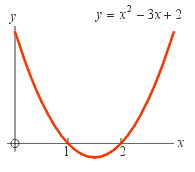 Example: Solve the quadratic equation
x 2 − 3 x + 2 = 0.
Example: Solve the quadratic equation
x 2 − 3 x + 2 = 0.Solution: Replace 0 with y to create the corresponding quadratic function
y = x 2 − 3 x + 2and draw its graph. The parabola crosses the x axis at x = 1 and x = 2. This means that the solutions of the quadratic equation x 2 − 3 x + 2 = 0 are x = 1 and x = 2.
2. Solving quadratic equations by factoring
The material in this section is based on the following topics, which you may want to first review: If the expression on the left-hand-side of the quadratic equation a x 2 + b x + c = 0 can be factored like this:(x − x1)(x − x2) = 0,then the solutions are x = x1 and x = x2. When you can spot the factors, this is probably the easiest of the four methods.
Example: Solve the quadratic equation x 2 + 3 = 4 x by factoring.
Solution: You must first put the quadratic equation into the standard form
x 2 − 4 x + 3 = 0.The left-hand-side can be factored:
(x − 1)(x − 3) = 0.Therefore the solutions of the quadratic equation are x = 1 and x = 3.
Warning: A common error is to think that the solutions are −1 and −3. This is not correct; the solutions are the values of x that make the factors vanish (become equal to zero). |
3. Solving quadratic equations by completing the square
The quadratic equation a x 2 + b x + c = 0 can be solved for x by completing the square. Here are the steps:- Transpose (add or subtract) the quadratic and linear terms to the
left-hand-side of the equation and the constant term to the right-hand-side:
a x 2 + b x = −c
- Divide both sides of the equation by a so that the coefficient of the
quadratic term is equal to 1:

- Take the coefficient of the linear term (namely b/a),
divide it by 2, and then square it.
This produces the quantity
 .
Add this quantity to both sides of the equation.
This turns the left hand side into a perfect square:
.
Add this quantity to both sides of the equation.
This turns the left hand side into a perfect square:

- Now factor the left hand side
and combine the fractions on the right hand side:

- Notice that this is now an equation in which the
unknown occurs just once.
This is the key result of the completing the square method.
Such an equation can always be solved by simply inverting the operations
that were applied to the unknown, one at a time,
starting with the last one, until x is isolated.
The first thing to do is to take the square root of both sides. This gives 2 equations, one with a + sign on the right hand side, the other with a − sign (this is indicated by the ± symbol):
- Next subtract
 from both sides:
from both sides:
This equation has a nice geometric interpretation. The two values of x are indicated by the red dots. The first term of the equation locates the midpoint (the point halfway between them) and the second term (the one after the ± symbol) gives the distance from the midpoint to either one of them:

- It is customary to combine the fractions on the right hand side of the
equation. The result is known as the quadratic formula:

Example: Solve the quadratic equation x 2 − 4 x + 3 = 0 by completing the square.
Solution: Here are the steps:
- Move the constant term to the right-hand-side:
x 2 − 4 x = −3.
- The coefficient of the linear term is −4. Taking half of it and squaring that gives 4.
Add this to both sides of the equation:
x 2 − 4 x + 4 = −3 + 4.
- This makes the left-hand-side a perfect square; rewrite it in factored form:
(x − 2) 2 = 1.
- Take the square root of both sides.
This leads to two equations as indicated by the ± sign on the right-hand-side.
x − 2 = ±1.
- Adding 2 to both sides gives the two solutions x = 1 and x = 3.
4. Solving quadratic equations by quadratic formula
The solutions of the quadratic equation a x 2 + b x + c = 0 are given by the quadratic formula:Note:
- The quadratic formula was derived by completing the square.
- There are two solutions. The + and − signs each give one of them.
- The quantity b 2 − 4 a c
under the square root is called the discriminant.
- If the discriminant is negative, then
the solutions are not real numbers (they are complex numbers) and the parabola
y = a x 2 + b x + c
does not cross the x axis.
- If the discriminant is zero, then the two solutions are equal (we also say that there
is one “double” root) and the parabola just touches the x axis.
Example: The solutions of the quadratic equation x 2 − 4 x + 3 = 0 can be found using the quadratic formula:
with a = 1, b = −4 and c = 3:
The + sign gives the solution x = 3 and the − sign gives the solution x = 1.

